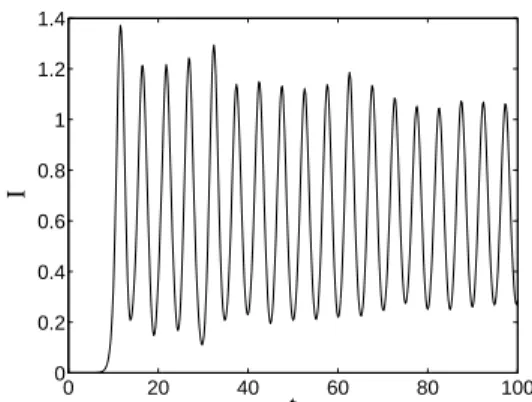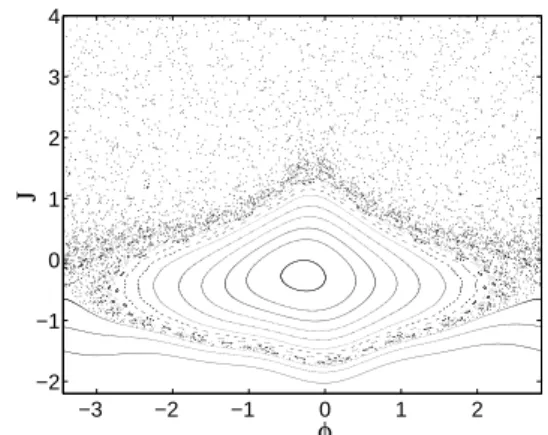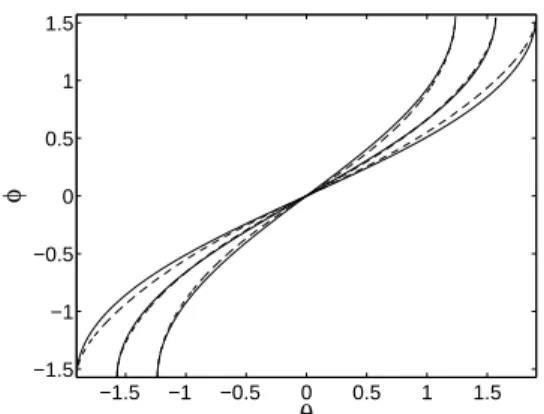HAL Id: hal-00102385
https://hal.archives-ouvertes.fr/hal-00102385
Submitted on 29 Sep 2006
HAL is a multi-disciplinary open access
archive for the deposit and dissemination of
sci-entific research documents, whether they are
pub-lished or not. The documents may come from
teaching and research institutions in France or
abroad, or from public or private research centers.
L’archive ouverte pluridisciplinaire HAL, est
destinée au dépôt et à la diffusion de documents
scientifiques de niveau recherche, publiés ou non,
émanant des établissements d’enseignement et de
recherche français ou étrangers, des laboratoires
publics ou privés.
Enhancement of particle trapping in the Free Electron
Laser
Romain Bachelard, Andrea Antoniazzi, Cristel Chandre, Duccio Fanelli,
Michel Vittot
To cite this version:
Romain Bachelard, Andrea Antoniazzi, Cristel Chandre, Duccio Fanelli, Michel Vittot. Enhancement
of particle trapping in the Free Electron Laser. Chaos06, Jun 2006, France. pp.73-77. �hal-00102385�
ccsd-00102385, version 1 - 29 Sep 2006
ENHANCEMENT OF PARTICLE TRAPPING IN THE FREE ELECTRON LASER
R. Bachelard∗, A. Antoniazzi∗∗, C. Chandre∗, D. Fanelli∗∗, M. Vittot∗
∗Centre de Physique Th´eorique, CNRS Luminy, Case 907, F-13288 Marseille Cedex 9, France1
∗∗Dipartimento di Energetica and CSDC, Universit`a di Firenze, INFN, via S. Marta, 3, 50139 Firenze, Italy
Abstract:The saturated dynamics of a Single Pass Free Electron Laser is here considered within a simplified mean field approach. A method is proposed to increase the size of the macro-particle. This approach is based on the reconstruction of invariant tori of the dynamics of test particles. To this aim a dedicated control term is derived, the latter acting as a small apt perturbation of the system dynamics. Implications of these findings are discussed in relation to the optimization of the laser source.Copyright c 2006 IFAC
Keywords: laser, control
INTRODUCTION
A Free Electron Laser (FEL) generates a tunable, coherent, high power radiation. A FEL differs from conventional lasers in using a relativistic electron beam as its lasing medium. The physi-cal mechanism responsible of the light emission and amplification is the interaction between a relativistic electron beam and a magnetostatic periodic field generated in the undulator. Due to the effect of the magnetic field, the elec-trons are forced to follow sinusoidal trajectories, thus emitting synchrotron radiation. This initial seed, termed spontaneous emission, is then am-plified along the undulator until the laser effect is reached.
Among different schemes, Single-Pass, high-gain FELs are particularly attractive since they hold the promise of resulting in flexible light sources of broad theoretical and applied interests. The
1 Unit´e Mixte de Recherche (UMR 6207) du CNRS, et
des universit´es Aix-Marseille I, Aix-Marseille II et du Sud Toulon-Var. Laboratoire affili´e `a la FRUMAM (FR 2291).
coupled evolution of the radiation field and the N particle beam in a Single-Pass FEL can be success-fully modeled within the framework of a simplified Hamiltonian picture Bonifacio, et al. (1990). The N + 1 degree of freedom Hamiltonian displays a kinetic contribution, associated with the par-ticles, and a potential term accounting for the self-consistent coupling between the particles and the field. Hence, direct inter-particles interactions are neglected, even though an effective coupling is indirectly provided because of the interaction with the wave.
The theory predicts a linear exponential insta-bility and a late oscillating saturation, for the amplitude of the radiation field. Inspection of the asymptotic phase-space suggests that a bunch of particles gets trapped in the resonance and forms a clump that evolves as a single macro-particle localized in space. The remaining particles are almost uniformly distributed between two oscillat-ing boundaries, and populate the so called chaotic sea.
This observation allowed to derive a simplified Hamiltonian model to characterize the saturated evolution of the laser. Such reduced formulation consists in only four degrees of freedom, namely the wave, the macro-particle and the two bound-aries, delimiting the portion of space occupied by the the uniform halo surrounding the inner bulk, see Antoniazzi et al. (2005) .
Furthermore, the macro-particle rotates around a well defined fixed point and this microscopic dy-namics is shown to be responsible for the macro-scopic oscillations observed at the intensity level. It can be therefore hypothesized that a signifi-cant reduction in the intensity fluctuations can be gained by implementing a dedicated control strategy, aimed at confining the macro-particle in space. In addition, the size of the macroparticle is directly related to the bunching parameter, a quantity of paramount importance in FEL con-text, see Antoniazzi and Fanelli (2005).
Smith and Pereira (1978) showed that a test-wave, being characterized by a frequency close to the one of the wave, can effectively destroy the macro-particle and activate a consequent detrapping pro-cess. Dimonte and Malmberg (1977) implemented this approach on a Travelling Wave Tube and detected a significant reduction of the intensity oscillations, followed, however, by an undisired systematic collapse of its mean-value.
In this paper, we focus on the macroparticle, spon-taneosuly established as a result of the wave par-ticle interaction process. In particular we develop a dedicated technique to influence and, possibly, control its evolution, thus opening up the perspec-tive of defining innovaperspec-tive approaches aiming at stabilizing the laser signal. To this end, we con-sider a test-particle Hamiltonian in a mean-field approach and calculate a small, but appropriate, control term which acts as a perturbation. The latter is shown to induce an increase in size of the macro-particle. A regularization of the dynamics is also observed, as confirmed by the reconstruc-tion of the invariant tori around the massive core. The paper is organized as follows. In Sec. 1, we in-troduce the mean-field model and shortly outline its derivation from the original N -body Hamil-tonian. In Sec. 2, a test-particle is “controlled”, through the reconstruction of invariant tori of its dynamics. Finally, we draw our conclusion and discuss possible implication of the present anal-ysis.
1. THE MEAN-FIELD MODEL
As previously anticipated, the dynamics of a Single-Pass FEL is successfully captured by the
0 20 40 60 80 100 0 0.2 0.4 0.6 0.8 1 1.2 1.4 t I
Figure 1. Normalized intensity of the FEL’s radi-ation simulated from Hamiltonian (1).
−3 −2 −1 0 1 2 3 −4 −3 −2 −1 0 1 2 3 θ p −3 −2 −1 0 1 2 3 −4 −3 −2 −1 0 1 2 3 θ p −3 −2 −1 0 1 2 3 −4 −3 −2 −1 0 1 2 3 θ p −3 −2 −1 0 1 2 3 −4 −3 −2 −1 0 1 2 3 θ p
Figure 2. Phase space of the N particles at t = 400, 401.25, 402.5 and 403.75.
following Hamiltonian introduced by Bonifacio and collaborators (1990): HN = N X i=1 [p 2 i 2 −2 r I N cos (θi+ φ)], (1) where (θi, pi) are the position and momentum of the i-th particle and (φ, I) stand respectively for the phase and intensity of the radiation. In the mean-field model, the conjugated variables (φ, I) are replaced by two functions of time φ(t) and I(t), obtained from direct simultations of the self-consistent dynamics. In other words, this amounts to formally neglect the action of the electrons on the field.
The N -body Hamiltonian (1) can be therefore mapped into ˜ HN = N X i=1 H1p(θi, pi, t), where H1p(θ, p, t) = p 2 2 −2 r I(t) N cos (θ + φ(t)). (2) The dynamics of a FEL can be hence adressed by studying the evolution of a test particle, obeying to the Hamiltonian (2). I(t) and φ(t) act as external parameters and are here imposed by assuming their simplified asymptotic behaviour as
obtained from a frequency analysis (Laskar, 1999) : 2 r I(t) N ≈F − ǫ K X k=1 Wkeiωkt , in the referential of the wave.
2. HAMILTONIAN CONTROL OF A TEST-PARTICLE
The Hamiltonian control adresses to systems which are close to integrable, i.e. whose Hamilto-nian can be written H = H0+V , where H0is inte-grable and V a perturbation of order ǫ (compared to H0). The results we use here have been proven rigorously (Vittot, 2004; Vittot et al., 2005). In practice, it can be shown that a suitable control term f , of order ǫ2, exists such that H0+ V + f has an invariant torus at a given frequency ω0. In our case, the perturbation corresponds to the oscillating part of the intensity. The interaction term of Hamiltonian (2) reads
2 r
I(t)
N cos (θ − φ(t)) = F cos θ − ǫRe(e
iθW (t)). Thus, our integrable Hamiltonian can be cast in the form
H0=p 2
2 −F cos θ, (3) whereas the time-dependent perturbation V is identified as
V (t, θ) = ǫRe(eiθW (t)). (4) In its action-angle variables (ϕ, J) (Lichtenberg and Libermann, 1983), Hamiltonian (3) can be expanded around J = J0, which in turn identifies the region where the invariant torus is recon-structed in.
H0(J) = E0+ω0(J−J0)+δ(J−J0)2+O((J−J0)3). Likewise, the θ-component of perturbation (4) is expanded as eiθ= M X m=0 L X n=−L αm,n(J − J0)meinϕ+ h.o.t.
The control term reads (Vittot et al., 2005) : f (ϕ, t) = V (J0, ϕ, t)−V (J0−Γ∂ϕV (J0, ϕ, t), ϕ, t), where Γ is a linear operator acting on an element of the Fourier basis as :
Γei(ωt+nϕ)= e i(ωt+nϕ) i(ω + n).
At the second order in ǫ (which is the main term), the control term reads
f (ϕ, t) = ǫ2w(ϕ, t)Γ∂ϕv(ϕ, t) − ǫ2δ(Γ∂ϕv(ϕ, t))2, where Γ∂ϕv(ϕ, t) =X k,n nα0,nWk ω0n + ωke i(nϕ+ωkt) , −3 −2 −1 0 1 2 −2 −1 0 1 2 3 4 φ J
Figure 3. Poincar´e section of the uncontrolled (H0 + V ) dynamics of a test particle, in action-angle variables. −3 −2 −1 0 1 2 −2 −1 0 1 2 3 4 J φ
Figure 4. Poincar´e section of the controlled (H0+ V + f ) dynamics of a test particle, in action-angle variables. and w(ϕ, t) =X k,n α1,nWkei(nϕ+ωkt) .
Numerically, two Fourier modes were considered for W (t) (K = 2), and eleven for the θ-dependent part of the perturbation (4) (L = 5). The pa-rameter of the perturbation is of order ǫ = 1/5. The development is performed around J0 ≈1.33 (which corresponds to energy E0= 0).
In action-angle variables, the regularization of the dynamics (see Figs.3 and 4) is manifest. Rather than a single torus, the control generated a con-tinuous set of invariant tori, thus expanding the regular domain of the phase space.
Unfortunately, the exact change of variables from (ϕ, J) to (θ, p) (see Lichtenberg and Libermann, 1983) has a singularity at the pendulum separa-trices. In order to implement our control on the whole dynamics, we use a simplified, but regular, change of variables which mimics the exact one in the region of the invariant torus predicted by the control (the error in this region is less than 4%) (see Fig.5) :
tan ϕ =θ p.
−1.5 −1 −0.5 0 0.5 1 1.5 −1.5 −1 −0.5 0 0.5 1 1.5 θ φ
Figure 5. Plot of the exact and simplified changes of variables : ϕ is plotted as a function of θ, at constant energy, i.e. at constant J. The solid lines corresponds to the exact change of variables, the dashed ones to the simplified. The curves corresponds (from left to right) to E = 0.5, 0 and −0.5.
In terms of the (θ, p) variables, our control term now reads :
˜
f (θ, p, t) = f (arctanθ p, t),
and its regularity is now the one of the function (θ, p) 7→ arctanθ
p. Therefore, the controlled dy-namics of a test-particle is given by Hamiltonian :
Hc(θ, p, t) = H1p(θ, p, t) + ˜f (θ, p, t) In the (θ, p) variables (see Figs.6 and 7), the con-trol is successful in reconstructing some invariant tori around the macro-particle. In other words, it enlarges this regular structure.
CONCLUSION
In this paper, we considered a simplified mean-field approach to investigate the saturated dy-namics of a Single Pass FEL. In particular, we showed that the size of the macro-particle can be increased by adding a small pertubation to the system, thus resulting in a low cost correction in term of energy. The main idea is to build invariant tori localized in specific positions: this method is utterly general and could be succesfully used to adjust the size of the macro-particle, thus possibly enhancing the bunching factor. Analogously, by limiting the portion of phase-space spanned by the macro-particle one could aim at stabilizing the laser signal. Two future lines of investigation are foreseen. First, we intend to implement the computed control term in the framework of the original N -body self-consistent picture and ex-plore possible beneficial effects for the evolution of the radiation field. Further, it is here planned to apply the above technique to the case of the reduced Hamiltonian of Antoniazzi and Fanelli (2005). We point out that an experimental test of
−3 −2 −1 0 1 2 3 −4 −3 −2 −1 0 1 2 3 4 θ p
Figure 6. Poincar´e section of the uncontrolled dynamics of a test particle, in the (θ, p) variables. −3 −2 −1 0 1 2 3 −4 −3 −2 −1 0 1 2 3 4 θ p
Figure 7. Poincar´e section of the controlled dy-namics of a test particle, in the (θ, p) vari-ables.
the control method on a modified Travelling Wave Tube has been done by Chandre and collaborators (2005) in absence of self-consistency.
REFERENCES
Antoniazzi, A. and D. Fanelli (2005). Statistical mechanics and Vlasov equation allows for a sim-plified Hamiltonian description of Single-Pass Free Electron Laser saturated dynamics, submitted to J. Phys. A.
Bonifacio, R., et al. (1990). Physics of the high-gain FEL and superradiance. Rivista del Nuovo Cimento, 3, pp. 1-69.
Chandre, C., G. Ciraolo, F. Doveil, R. Lima, A. Macor and M. Vittot (2005). Channeling chaos by building barriers. Phys. Rev. Lett., 74, 074101. Dimonte, G., J.H. Malmberg (1977). Destruction of Trapped-Particle Ocillations. Phys. Rev. Lett., 38, pp. 401-404.
Laskar, J. (1999). Introduction to Frequency Map Analysis. Proc. of NATO ASI Hamiltonian Sys-tems with Three or More Degrees of Freedom,(C. Sim`o Ed, Kluwer), pp. 134-150.
Lichtenberg, A.J. and M.A. Libermann (1983). Regular and Stochastic Motion. Springer, New York.
Smith, G.R. and N.R. Pereira (1978). Phase-locked particle motion in a large-amplitude plasma wave. Phys. Fluids, 21, pp. 2253-2262.
Tennyson, J.L., J.D. Meiss, and P.J. Morri-son (1994). Self-Consistent Chaos in the Beam-Plasma Instability. Physica D, 71, pp. 1-17. Vittot, M. (2004). Perturbation theory and con-trol in classical or quantum mechanics by an in-version formula. J. Phys. A: Math. Gen., 37, pp. 6337-6357.
Vittot, M., C. Chandre, G. Ciraolo and R. Lima (2005). Localized control for non-resonant Hamil-tonian systems. Nonlinearity, 18, pp. 423-440.


